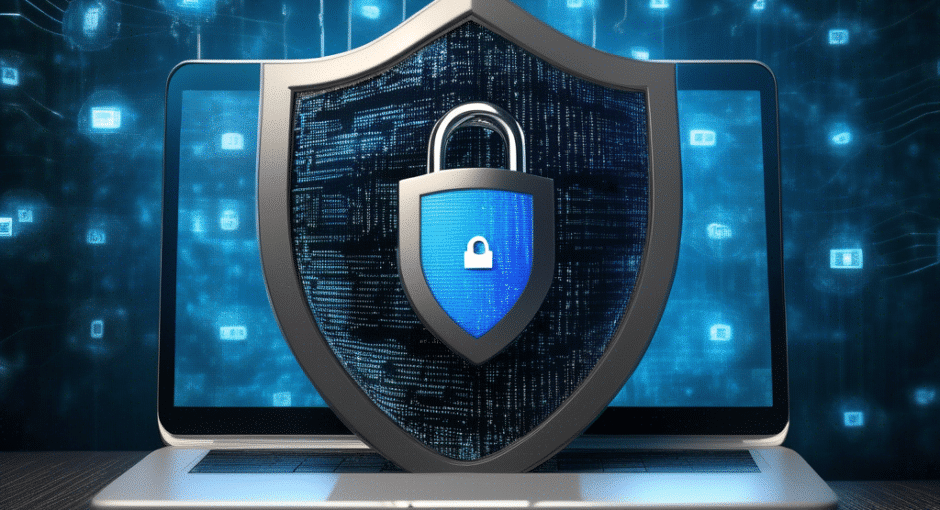In today’s digital age, cybersecurity has become a pressing concern for individuals and organizations alike. With cyber threats growing more sophisticated each day, it is crucial for everyday users to stay informed and take necessary precautions to protect themselves online. This article aims to provide essential cybersecurity tips for everyday users, empowering them through education and equipping them with the knowledge and tools to navigate the digital landscape safely. By adopting these end user security practices, you can fortify your digital defense and keep cyber threats at bay. So, whether you’re a college student, a working professional, or simply someone who values their online privacy, this article is here to help you navigate the complex world of cybersecurity and ensure a safer digital experience.
- 1. "Protecting Yourself Online: Essential Cybersecurity Tips for Everyday Users"
- 2. "Empowering Users through Cybersecurity Education: Daily Tips for a Safer Digital Experience"
- 3. "Strengthening Your Digital Defense: End User Security Practices to Keep Cyber Threats at Bay"
1. "Protecting Yourself Online: Essential Cybersecurity Tips for Everyday Users"
Protecting Yourself Online: Essential Cybersecurity Tips for Everyday Users
In today’s digital age, cybersecurity has become more important than ever. With cyber threats and attacks on the rise, it is crucial for everyday users to be aware of the risks and take proactive steps to protect themselves online. In this section, we will discuss some essential cybersecurity tips that everyone should follow to ensure their online safety.
1. Keep your devices up to date: One of the most basic yet effective ways to protect yourself online is to keep your devices, including computers, smartphones, and tablets, up to date. Regularly installing software updates and security patches helps fix vulnerabilities that hackers can exploit.
2. Use strong, unique passwords: It’s common knowledge that using strong passwords is essential, but many people still fall into the trap of using weak and easily guessable passwords. Ensure your passwords are at least eight characters long and include a mix of uppercase and lowercase letters, numbers, and special characters. Moreover, avoid using the same password for multiple accounts, as this can make all your accounts vulnerable if one gets compromised.
3. Enable two-factor authentication (2FA): Two-factor authentication adds an extra layer of security to your online accounts. By requiring a second form of verification, such as a unique code sent to your phone, even if someone manages to obtain your password, they won’t be able to access your account without the additional verification.
4. Be cautious of phishing attempts: Phishing is a common technique used by cybercriminals to trick users into revealing sensitive information. Be wary of suspicious emails, messages, or calls that ask for personal or financial information. Avoid clicking on unknown links or downloading attachments from untrusted sources.
5. Use a reliable antivirus software: Invest in a reputable antivirus software and keep it updated. Antivirus software helps detect and remove malware, viruses, and other malicious programs that can compromise your online security.
6. Be mindful of public Wi-Fi: Public Wi-Fi networks are often unsecured and can be easily exploited by hackers. Avoid accessing sensitive information, such as online banking or shopping, when connected to public Wi-Fi. If you must use public networks, consider using a virtual private network (VPN) to encrypt your internet connection and protect your data.
7. Regularly back up your data: Backing up your important files and data regularly is crucial in case of a cyber attack or hardware failure. Use external hard drives, cloud storage, or other backup solutions to ensure you can recover your data if it is compromised.
8. Stay informed about cybersecurity best practices: Cyber threats are constantly evolving, and it’s essential to stay updated on the latest cybersecurity best practices. Follow reputable cybersecurity news sources, attend webinars or workshops, and consider taking online courses to enhance your cybersecurity knowledge and skills.
By following these essential cybersecurity tips, everyday users can significantly reduce their risk of falling victim to cyber threats. Remember, cybersecurity is a shared responsibility, and investing in your own cybersecurity education is the first step towards a safer online experience. Stay vigilant, stay informed, and stay secure.
2. "Empowering Users through Cybersecurity Education: Daily Tips for a Safer Digital Experience"
Empowering Users through Cybersecurity Education: Daily Tips for a Safer Digital Experience
In today’s increasingly connected world, cybersecurity has become a critical concern for individuals and organizations alike. With cyber threats constantly evolving and becoming more sophisticated, it is essential for users to be equipped with the knowledge and skills to protect themselves online. This is where cybersecurity education plays a vital role in empowering users to have a safer digital experience.
End user security is often the weakest link in the cybersecurity chain. Attackers target individuals because they are more likely to fall for social engineering tactics or unknowingly download malicious files. This is why educating end users about cybersecurity best practices is crucial in preventing cyber attacks.
One effective way to empower users is through daily cybersecurity tips. By providing users with actionable advice on a regular basis, they can develop a habit of practicing good cybersecurity hygiene. These tips can cover a wide range of topics, such as password management, phishing awareness, software updates, safe browsing habits, and secure online transactions.
For instance, a daily tip could emphasize the importance of using strong, unique passwords for each online account. Users may be encouraged to use a password manager to generate and store complex passwords securely. Another tip could focus on recognizing phishing attempts and avoiding clicking on suspicious links or opening email attachments from unknown sources.
Regularly reminding users to keep their software up to date is another critical tip. Software updates often include security patches that address vulnerabilities. By installing updates promptly, users can protect themselves from known vulnerabilities that attackers may exploit.
Safe browsing habits are also essential for a secure digital experience. Users should be educated about the risks associated with visiting untrusted websites, downloading files from unknown sources, and clicking on pop-up ads. Encouraging the use of ad-blockers and security plugins can further enhance online safety.
Lastly, daily tips can educate users about secure online transactions. Users should be reminded to look for the padlock symbol indicating a secure connection (HTTPS) when making online purchases or entering sensitive information. Furthermore, they should be cautious about sharing personal or financial information over unsecured Wi-Fi networks.
By incorporating these daily tips into their routine, users can develop a strong cybersecurity mindset. Continuous education is key to staying ahead of the ever-evolving threat landscape. Cybersecurity education initiatives should be accessible, engaging, and tailored to the needs of different user groups.
Ultimately, empowering users through cybersecurity education helps create a more secure digital environment. By equipping individuals with the knowledge and skills to protect themselves, we can collectively strengthen the overall cybersecurity posture and mitigate the risks posed by cyber threats. So, let’s embrace the power of daily cybersecurity tips and work towards a safer digital future.
3. "Strengthening Your Digital Defense: End User Security Practices to Keep Cyber Threats at Bay"
In today’s digital age, cybersecurity has become an essential aspect of our lives. With cyber threats becoming more sophisticated and prevalent, it is crucial for individuals to adopt strong security practices to protect their personal information and online activities. By strengthening our digital defense, we can significantly reduce the risk of falling victim to cybercrime.
1. Keep your software updated: One of the easiest ways for cybercriminals to exploit vulnerabilities is through outdated software. Regularly updating your operating system, web browsers, antivirus programs, and other software ensures that you have the latest security patches and protections. Enable automatic updates whenever possible to stay up-to-date effortlessly.
2. Use strong and unique passwords: Passwords remain the primary line of defense for most online accounts. Create strong, complex passwords that include a combination of uppercase and lowercase letters, numbers, and special characters. Avoid using easily guessable information like birthdays or pet names. Furthermore, it is essential to use unique passwords for each online account to prevent attackers from gaining access to multiple accounts if one password is compromised. Consider using a password manager to securely store and generate strong passwords.
3. Enable two-factor authentication (2FA): Two-factor authentication adds an extra layer of security to your online accounts. It requires users to provide a second form of verification, usually a unique code sent to their mobile device, in addition to their password. By enabling 2FA, even if an attacker manages to obtain your password, they would still need physical access to your mobile device to gain entry. This significantly reduces the likelihood of unauthorized access.
4. Be cautious with email and attachments: Phishing attacks, where attackers try to trick individuals into revealing sensitive information or downloading malware, are a common cybersecurity threat. Always be skeptical of unsolicited emails, especially those asking for personal information or containing suspicious attachments. Avoid clicking on links in emails unless you are certain of their legitimacy. When in doubt, contact the sender through a separate trusted channel to verify the email’s authenticity.
5. Practice safe browsing habits: Be mindful of the websites you visit and the links you click on. Stick to reputable websites and avoid downloading files from unknown sources. Implement browser extensions that warn against malicious websites or block pop-up advertisements. Additionally, consider using a virtual private network (VPN) when connecting to public Wi-Fi networks to encrypt your internet traffic and protect your data from potential eavesdroppers.
6. Educate yourself about cybersecurity: Stay informed about the latest cybersecurity threats and best practices. Educate yourself on common attack techniques, such as phishing, social engineering, and malware. Regularly read reputable cybersecurity blogs, follow cybersecurity experts on social media, and attend webinars or workshops to enhance your knowledge. The more educated you are, the better equipped you will be to protect yourself against cyber threats.
By implementing these end-user security practices, you can significantly enhance your digital defense and reduce the risk of falling victim to cyber threats. Remember, cybersecurity education is an ongoing process, and staying vigilant is key in our ever-evolving digital landscape.
In today’s digital age, cybersecurity has become more important than ever. With cyber threats lurking around every corner, it is crucial for everyday users to take proactive measures to protect themselves online. This article has provided essential cybersecurity tips for users of all levels, empowering them to navigate the digital landscape with confidence and security.
One of the key takeaways from this article is the importance of cybersecurity education. By staying informed and up to date on the latest threats and best practices, users can strengthen their digital defense and minimize the risk of falling victim to cyber attacks. The daily tips offered in this article serve as a reminder that cybersecurity is not a one-time task, but a continuous effort to stay vigilant and proactive.
End user security practices play a significant role in keeping cyber threats at bay. From creating strong and unique passwords to utilizing reputable antivirus software, these practices serve as the first line of defense against potential breaches. By implementing these measures into their daily routines, users can significantly reduce the risk of becoming a target.
In conclusion, cybersecurity is no longer just a concern for IT professionals and businesses. It is a responsibility that falls on the shoulders of everyday users. By taking the necessary steps to protect themselves online and staying informed through cybersecurity education, users can navigate the digital world with confidence and peace of mind. Let us all remember that when it comes to cybersecurity, knowledge is power, and taking action is essential.






